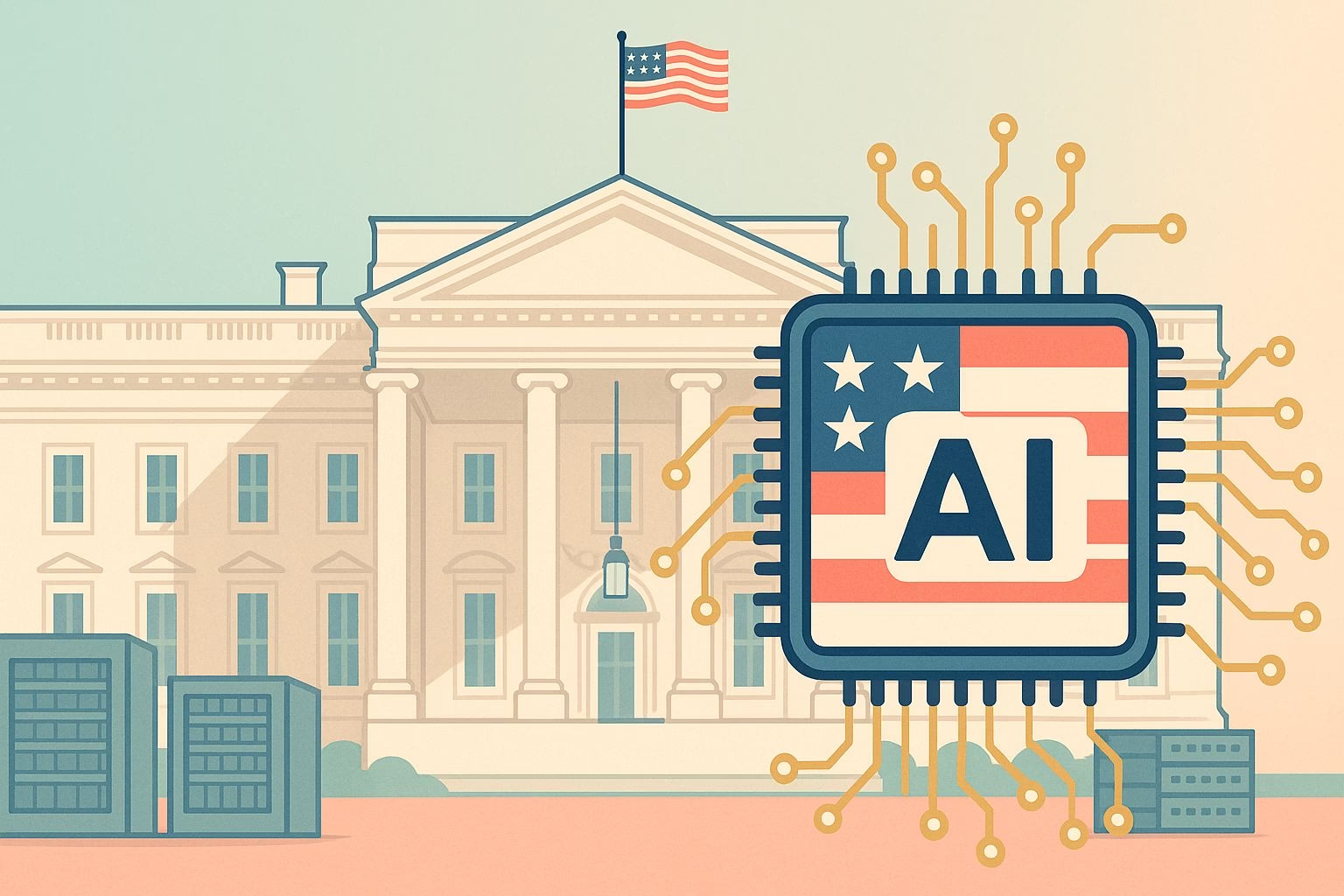Ethical Guardrails Are Missing from America’s AI Action Plan
America just hit the accelerator on AI policy. On July 23, the White House unveiled Winning the AI Race: America’s AI Action Plan.
The roadmap includes over 90 federal actions covering innovation, infrastructure, and diplomacy.
It fast-tracks construction of AI infrastructure, opens data center permitting, and mandates ideological neutrality in government AI contracts, meaning no DEI-based models are allowed under federal procurement.
What the Plan Means Today
The three executive orders drive this agenda hard:
-
Accelerating Data Center Permits for faster buildouts on federal lands and easing environmental reviews.
-
Promoting AI Export Strategy to allied nations with packaged hardware and models.
-
Preventing “Woke AI” in Federal Use, banning DEI-influenced model development.
That approach reflects a sharp ideological shift. Big tech leaders already signaled support. Nvidia’s Jensen Huang and AMD’s Lisa Su publicly endorsed the plan—viewing it as a direct boost to capacity and exports.
Google also recently raised its AI infrastructure capex projection to $85 billion, buoyed by demand.
ServiceNow’s $100 million savings from internal AI automation illustrates how quickly the workforce shift is real, especially in administrative and clerical roles .
What’s at Stake
Workforce Disruption
Automation gains might mean leaner operations, but what about the displaced roles?
Corporate restructuring now replaces jobs previously safe from AI. Without policy buffers, displaced workers may struggle to adapt.
Ethics and Accountability
Removing references to DEI, misinformation, and climate change from government AI policy signals a shift away from value-driven AI design toward “neutrality.” But neutrality is subjective.
Who defines that?
Risk of bias and censorship looms.
Environmental Oversight
Data center expansion often hits environmental bottlenecks, including increased power demand, water usage, and carbon impact. Fast-tracked approvals raise questions about sustainability trade-offs.
Four Critical Questions Policymakers Must Answer
-
Can infrastructure growth include safety, job transition, and climate guardrails?
Permitting fast is fine—so long as the cost-benefit includes displaced workers and environmental footprint. -
Who defines neutrality—and how do we guard against suppression?
Mandated neutrality could erode academic and social discourse if not carefully framed. -
Which middle-class jobs face automation risk next?
ServiceNow’s automation is a sign. Beyond admin, expect action in finance, marketing, HR. Build retraining into the strategy. -
Can federal action finance guardrails alongside growth?
Oversight budgets, enforcement mechanisms, and safety protocols must keep pace.
What Should Stakeholders Do
Government
Negotiate infrastructure permits only when developers submit thorough impact assessments that include job‑loss mitigation plans, clear energy sourcing priorities, detailed audit trails for AI deployments, and frameworks for diversity, equity, and inclusion where legally applicable.
Tie permit approvals to demonstrable commitments such as workforce retraining funds and renewable energy procurement.
Require periodic public reporting on progress toward those commitments to maintain accountability.
Industry
Commit to full transparency around AI automation risks by publishing regular impact statements that outline how many positions may be displaced, what new roles will be created, and what reskilling programs are in place.
Establish independent oversight boards that review and certify ethical compliance for major AI projects.
Maintain open channels for stakeholder feedback and publish case studies on both successes and challenges in workforce transformation.
Regulators
Make public funding, procurement, and licensing conditional on meeting baseline standards in fairness, algorithmic transparency, and user safety.
Develop clear certification processes for AI products that verify bias testing, data‑privacy safeguards, and environmental impact controls.
Enforce compliance with measurable penalties for violations, and revisit standards regularly to keep pace with rapid technological change.
Public
Elevate the conversation by demanding that AI vendors answer four key questions:
- Does your system uphold rigorous ethical guidelines?
- How are you protecting existing jobs and supporting displaced workers?
- What data‑privacy protections are in place?
- How are you managing environmental and energy impacts?
If vendors cannot provide satisfactory answers, pressure them through customer feedback, industry watchdogs, and, where appropriate, regulatory complaints.
Charting a Responsible AI Future
Rolling out AI at scale doesn’t require choosing between progress and principle.
Governments, corporations, and regulators can collaborate on concrete frameworks to ensure innovation aligns with sustainability and ethics:
-
Tie Infrastructure to Green Building Standards
Require all new AI data centers and chip fabs to meet certified green‑building benchmarks, covering energy efficiency, renewable sourcing, and water conservation. Permit approvals should hinge on third‑party verification of LEED or equivalent ratings, ensuring facilities contribute to decarbonization goals rather than undermine them. -
Fund Reskilling for Displaced Workers
Establish jointly financed workforce transition programs that guarantee training stipends, certification courses, and job‑placement assistance for employees affected by AI automation. Corporations benefiting from automation tax incentives can direct a portion of savings into regional upskilling funds, creating career pathways in AI maintenance, ethics auditing, and green tech. -
Implement Transparent “Neutrality‑Adjacent” Oversight
Develop clear guidelines for “neutral” AI, especially in government use, by defining allowable value frameworks and prohibited biases. Create independent oversight councils, with public members and technical experts, to audit model behavior, publish summary reports, and recommend adjustments when AI outputs drift into controversial territory. -
Track and Publish Ethical Compliance Metrics
Mandate routine disclosure of key performance indicators, such as bias test results, privacy incident counts, and environmental footprints, for all major AI deployments. Publish these metrics in an accessible online registry, enabling stakeholders and watchdogs to monitor compliance, compare across vendors, and hold organizations accountable in real time.
By embedding these steps into policy and practice, we can advance AI rapidly while protecting people, planet, and principles.
Final Thoughts
The AI Action Plan charts an ambitious course to cement U.S. leadership. But leadership grounded in speed without guardrails risks long-term fallout, from divided public trust and displaced workers to unchecked environmental impact.
If we intend to lead in AI, then let it be with accountability, not just acceleration. America can innovate boldly and responsibly. The best race is one we finish with integrity intact.

